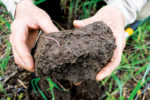Advertise Follow Us
ARTICLES
Lessons from the Field: How Growers Profit from Regenerative Soils
Increasing plant diversity, adding livestock and following a simple soil-testing program can significantly add to the bottom line, growers say.
Read More
Crunching Data on Regenerative Farm and Ranch Management
Intercropping, adaptive grazing systems can improve crop synergies, soil health benchmarks and overall ranch profitability, experts say.
Read More
Soil Microbes Have Power to Reverse Climate Change
Many problems identified with the planet’s climate could be solved by putting water back in the ground where it belongs, says Christine Jones.
Read More
Putting Quorum Sensing to Work in Your No-Tilled Soils
No-tillers must embrace diversity in plants and soil microbes to unlock the power of quorum sensing, improve ag production and deal with climate change, says Christine Jones.
Read More
In Depth: The Money-Making Power of Soil Microbes
Reducing soil disturbance, increasing plant diversity and adding livestock to farms accelerates soil health and productivity, helping growers stay profitable, soil experts say.
Read More
No-Tillers Getting a Yield, Soil Health Boost from Intercropping
These Canadians growers tossed aside cold-weather, growing-season excuses and are interseeding diverse crops and covers to boost revenue and reduce financial risk.
By Angela Lovell
posted on
February 23, 2019
| Posted in Nutrient Management, Seeding & Planting, Soil Health
Read More
Tips for Managing Cover Crop Mixes for More No-Till Benefits
Choosing a cover crop cocktail is only a start, says Adam Daugherty, as managing carbon-to-nitrogen ratios and adapting planting strategies play a big role in success.
By Angela Lovell
posted on
November 20, 2018
| Posted in Cover Crops, Residue Management, Soil Health
Read More
Getting Out of the Rut with No-Tilling, Cover Crop Interseeding, Weed Suppression
Tom Cotter is boosting the value of his soils in the heart of the Corn Belt by putting the iron away and keeping his fields covered and active year round.
By Angela Lovell
posted on
October 31, 2018
| Posted in Cover Crops, Seeding & Planting, Soil Health
Read More
Make Covers a Forage Option for Better No-Till Profitability
Many cover crops are efficient, effective feed sources for livestock if they’re seeded properly and managed for optimum animal and soil health.
By Angela Lovell
posted on
September 13, 2018
| Posted in Cover Crops, Nutrient Management, Soil Health
Read More
Top Articles
Current Issue
No-Till Farmer
Get full access NOW to the most comprehensive, powerful and easy-to-use online resource for no-tillage practices. Just one good idea will pay for your subscription hundreds of times over.
Soil Health Principle 4: Continual Living Plant
Regenerating Your Profits: No-Till, Covers & Livestock
Good or Bad, We’re in for Some Interesting Times for Conservation Ag
Must Read Free Eguides
Download these helpful knowledge building tools
- How Beneficial Insects, Pollinators Can Boost No-Till Resilience
- How No-Till Improves Your Land Value
- 5 Pillars for No-Till Farming Effectively, Efficiently
- Making the Precision Basics Even Better with Implement Guidance
Videos
Farmer Shares Formula for Better No-Till Corn Emergence
On this episode of Conservation Ag Update, brought to you by Yetter Farm Equipment, longtime no-tiller Ross Bishop shares some of the keys to achieving even corn emergence with no-till.
Events
Conservation in Action Tour 2025 -- Sioux Falls, S.D.
Date: 05/06/25
Location:
View Event
Top Directory Listings
Needham Ag Technologies, LLC
Needham Ag understands the role of technology in making better use of limited resources within a specific environment by drawing on a wealth of global experience to overcome the challenges facing today's farmers, manufacturers and dealers.
Titan International, Inc
Titan offers a full line of wheels, tires and undercarriage products for a wide variety of off-the-road equipment.
The Andersons PureGrade
The Andersons grows enduring relationships through extraordinary service, a deep knowledge of the market, and a knack for finding new ways to add value as we have done for nearly 70 years.














